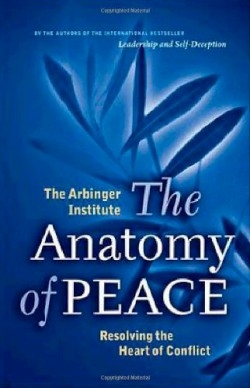The Anatomy of Peace
Resolving the Heart of Conflict
This is the story of a life-changing weekend. A group of parents and guardians have dropped off their troubled teens at a Phoenix treatment center. While the kids are preparing for a sixty-day wilderness excursion, their parents have agreed to spend two days in a workshop setting in the care of Avi and Yusuf, a Jew and an Arab who run Camp Moriah.
The parents expect to find out how the center will fix their kids, but Avi and Yusuf, drawing mostly on their own personal experiences and using group discussion and a few diagrams and charts, take turns introducing the group to an unexpected set of ideas about interpersonal conflict. Here are a few of them: “We can invite others to change, but the most fundamental change must occur in ourselves,” “Conflicts are rarely solved by ‘correction,’” and “A ‘heart at peace’ is the most necessary requisite for resolution.”
At first, this information does not sit well with Lou Herbert, a Vietnam vet and the president of Zagrum Company, who has accompanied his son Cory to Camp Moriah. At war with Cory and skeptical about the camp’s methods from the outset, Lou is also preoccupied with a mutiny that is taking place in his company. But his wife, Carol, insists that they stay, and Lou, the most vocal and dynamic of the parents at Camp Moriah, begins to listen. His transformation, from a bull-headed tyrant to a man on a mission to bring peace to himself, his family, and his company, is the book’s central drama. Lou, Carol, and the other parents discover the “box” that people in conflict often find themselves in, and the various justifications for their thinking that keep them in that box. Then they learn strategies for getting out of the box—for achieving personal peace and for making peace around them. This book is not a novel, but Camp Moriah serves as an apt setting for this most profound lesson in seeing the other, à la Martin Buber, as “a ‘thou’ rather than an ‘it.’”
The Arbinger Institute is “a management training and consulting firm and scholarly consortium.” One of their earlier books, Leadership and Self-Deception, used a variation on the same idea—the problem of always seeing the other as the source—to examine conflict in the workplace. The Anatomy of Peace looks at harmony in all human interaction: in the home, at work, and in communities. Co-written by a team led by the Institute’s directors, the book can be read as self-help—it helps the reader look at his or her own heart. But it also shows how to “help things go right,” rather than merely put up with things that have gone wrong.
Reviewed by
Joe Taylor
Disclosure: This article is not an endorsement, but a review. The publisher of this book provided free copies of the book to have their book reviewed by a professional reviewer. No fee was paid by the publisher for this review. Foreword Reviews only recommends books that we love. Foreword Magazine, Inc. is disclosing this in accordance with the Federal Trade Commission’s 16 CFR, Part 255.

